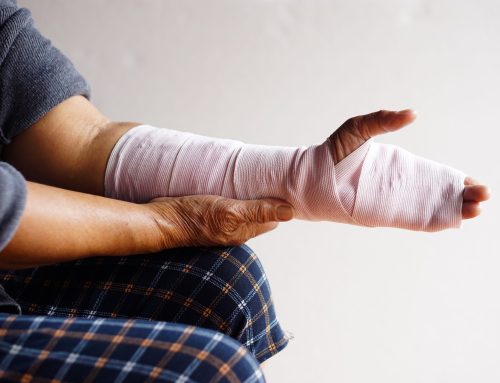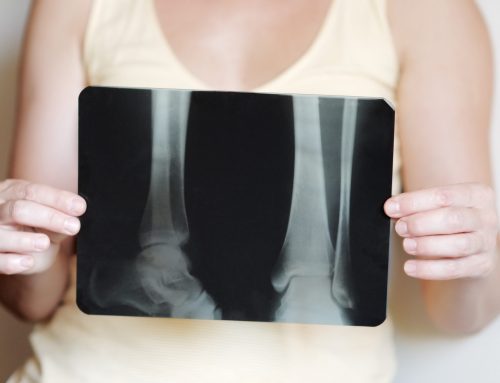Recovering from a hip fracture can be a complex process, requiring careful steps to ensure the best possible outcomes. Most people can’t walk during the early stages of the healing process, and it can be excruciating to do so. In this guide, we’ll walk you through each stage of recovery, highlighting essential aspects that contribute to healing and a return to everyday life.

Understanding Hip Fractures
Hip fractures are serious injuries that predominantly affect older adults and those with weakened bones. They are often a result of falls and can lead to significant mobility and lifestyle changes. The recovery process can be frustrating while you wait to get back to pre-injury living, but there is a light at the end of the tunnel. Here’s what you can expect during a hip fracture recovery.
Immediate Response and Treatment: The journey to recovery starts with immediate medical attention. Prompt treatment is crucial to prevent complications and begin the healing process.
Surgical Intervention: Most hip fractures require surgery to repair or replace the damaged area. The type of surgery depends on the nature and location of the fracture.
Hospital Recovery Phase: A hospital stay is necessary for initial recovery after surgery. This period involves close monitoring, pain management, and the beginning of rehabilitation.
Rehabilitation in the Hospital: Physical therapy starts as soon as possible, often within a day after surgery. Early movement is key to preventing complications and promoting healing.
Transitioning to Home: Ensuring a safe home environment is essential before discharge. Remove tripping hazards and install assistive devices like handrails in bathrooms.
Ongoing Rehabilitation: Recovery continues at home with a customized physical therapy program. This may include exercises to improve strength, balance, and mobility.
Understanding the seriousness of hip fractures and undergoing the right treatment and rehabilitation are fundamental steps toward healing. Each stage is a vital part of the recovery process, from the initial medical response and surgical intervention to the crucial rehabilitation phases in the hospital and at home.
As you transition from the structured environment of the hospital to the familiarity of your home, the recovery journey takes on a new dimension. Here, the focus shifts to adapting your living space for safety and comfort, continuing with personalized rehabilitation, and gradually regaining your strength and mobility. This phase is as much about physical recovery as it is about mental and emotional resilience.
The road to recovery from a hip fracture is not just about healing bones; it's about reclaiming your independence and quality of life. You can navigate this journey successfully with patience, determination, and the right support. As you move beyond the hospital's walls, remember that each day brings you closer to your goals of mobility and wellness.
In the next section, "Healing Hip Fractures Beyond The Hospital," we will explore how the recovery journey continues outside the hospital setting, focusing on long-term healing strategies and innovative technologies to aid your recovery process further.
Healing Hip Fractures Beyond The Hospital
You’re not going to be staying in the hospital for the entirety of the healing process. While you can’t wave a magic wand to make your fracture heal faster, there are some things you can do to support the process.
Nutritional Support: A balanced diet rich in calcium, vitamin D, and protein supports bone healing. Proper nutrition is a cornerstone of recovery.
Lifestyle Modifications: Quitting smoking and moderating alcohol intake are vital lifestyle changes that enhance healing and overall health.
Pain Management and Monitoring: Managing pain is critical for rehabilitation. This includes prescribed medications and simpler methods like ice and rest.
Regular Medical Checkups: Frequent follow-ups with healthcare professionals ensure proper healing and provide an opportunity to address any concerns.
Integrating Advanced Technologies: Modern recovery processes embrace advanced technologies to enhance and accelerate healing.
When it comes to tech and fracture healing, there is a NASA-inspired device you may want to know about.
The Role of Low-Intensity Pulsed Ultrasound (LIPUS)
LIPUS is a groundbreaking technology that has remarkably improved fracture healing. How does this revolutionary tool fit into the recovery process? Let’s dive into the details.
The Melmak device uses LIPUS technology to stimulate the bone at the cellular level, promoting faster healing. It’s a non-invasive, painless treatment that’s easy to use and can be administered at home.
Proven Efficacy: Clinical studies have shown that using LIPUS technology can significantly speed up the healing of fractures. The Melmak device, in particular, has a track record of over 20 years of successful outcomes with no known side effects.
Daily Treatment Routine: Incorporating the Melmak device into your daily routine is simple. A 20-minute session each day can expedite your recovery, helping you return to normal activities quicker.
Hip fracture recovery is a journey that involves several stages, from immediate medical care to advanced healing techniques like LIPUS. By understanding each step and utilizing the best available resources, such as the LIPUS device, patients can look forward to a more efficient and effective recovery. Remember, every step you take towards recovery, no matter how small, is a stride towards regaining your independence and quality of life.
For more information about incorporating advanced recovery tools like the Melmak LIPUS device into your hip fracture recovery process, feel free to reach out to us. We are committed to supporting you on your journey to healing and wellness.
Have you or anyone you’ve known experienced a hip fracture? What was the recovery process like? Share your experience with our readers in the comments below.






Leave A Comment